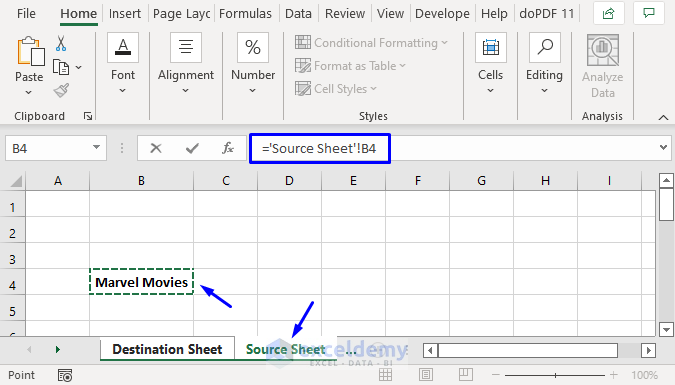5 Ways to Link Excel Sheets Efficiently

Effective data management often requires linking multiple Excel sheets, whether for summarizing sales figures, tracking project updates, or compiling data from various sources. Linking sheets can streamline workflows, reduce redundancy, and ensure data consistency across documents. Here are five efficient ways to link Excel sheets, complete with step-by-step guidance.
1. Using External References

One of the simplest ways to link sheets within the same workbook or across different workbooks is through external references or links.
- Open Source Workbook: Start by ensuring the workbook you want to link from is open.
- Create Reference: In your destination sheet, select the cell where you want the data to appear, then type = (equals sign) and click on the cell or range from the source sheet that contains the data. Excel will automatically generate a formula like
=[SourceWorkbook.xlsx]Sheet1!A1. - Apply: Press Enter to link the data. The link will update dynamically if the source data changes.
🔹 Note: Ensure file paths are consistent to avoid breaking links when moving workbooks.
2. VLOOKUP and HLOOKUP Functions

These functions are useful for pulling specific data from one sheet to another based on matching criteria.
- VLOOKUP Syntax:
=VLOOKUP(lookup_value, table_array, col_index_num, [range_lookup]) - Example: If you want to pull the price from the 'Inventory' sheet into the 'Sales' sheet, use
=VLOOKUP(A2, Inventory!A1:B50, 2, FALSE)assuming the price is in the second column of the range. - Considerations: These functions are useful but limited to searching vertically or horizontally within one range. For complex or multiple criteria searches, consider using INDEX and MATCH functions.
🔹 Note: VLOOKUP assumes the column order does not change. Use with caution if restructuring data.
3. Named Ranges

Naming ranges can make linking sheets easier, especially when dealing with complex spreadsheets.
- Define Names: Go to Formulas > Name Manager or press Ctrl+F3, and define a name for your range, e.g., 'Products' for a range listing product names and prices.
- Linking with Names: Now, you can refer to this named range in any formula, like
=Productsor=SUM(Products). - Benefits: Named ranges make formulas more readable and less prone to errors if cell references change.
4. Power Query

For more advanced Excel users, Power Query offers powerful data manipulation and linking capabilities.
- Import Data: Use 'Get Data' from the 'Data' tab to import data from various sources.
- Transform Data: Clean, transform, and organize data as needed using Power Query Editor.
- Load and Link: After transforming, you can load this data into your workbook, creating linked tables or pivot tables that will update automatically with changes in the source.
5. Using INDIRECT Function

The INDIRECT function allows dynamic cell referencing, ideal for scenarios where data location might change.
- Syntax:
=INDIRECT(ref_text)where ref_text is a cell reference string. - Example: If cell A1 contains 'Sheet2!A1', using
=INDIRECT(A1)will return the value in Sheet2 A1. - Dynamic Linking: This function is particularly useful when linking sheets whose names might change or when user input dynamically references data.
🔹 Note: Use INDIRECT cautiously as it can slow down larger Excel files.
In the complex world of spreadsheet management, efficient linking is key to maintaining accuracy and real-time data updates. Whether through simple external references, lookup functions, named ranges, Power Query, or dynamic referencing with INDIRECT, Excel provides a wide array of tools for users to interconnect their data efficiently. By mastering these techniques, businesses, analysts, and individuals can leverage Excel's power to create a cohesive data management system, enhancing productivity and decision-making processes.
Can I link Excel sheets from different workbooks?

+
Yes, you can link Excel sheets across different workbooks using external references or even Power Query to combine data from multiple files.
What if my link breaks when I change the file location?

+
When you move or rename the source workbook, you need to update the link manually in Excel or use file paths carefully to avoid link errors.
How does Power Query differ from traditional linking methods?

+
Power Query allows for more complex data transformation and integration, often with automated updates, offering a more robust solution than manual linking with formulas.
What should I do if Excel warns about too many links?

+
Consider using Power Query or consolidating data into fewer sheets or workbooks to reduce the number of links. Excel’s performance can suffer with too many external references.
Is there a way to secure linked data?

+
To secure linked data, you can protect the workbook or sheet where the data is sourced from, use passwords for workbooks, or limit access to files containing sensitive data.



